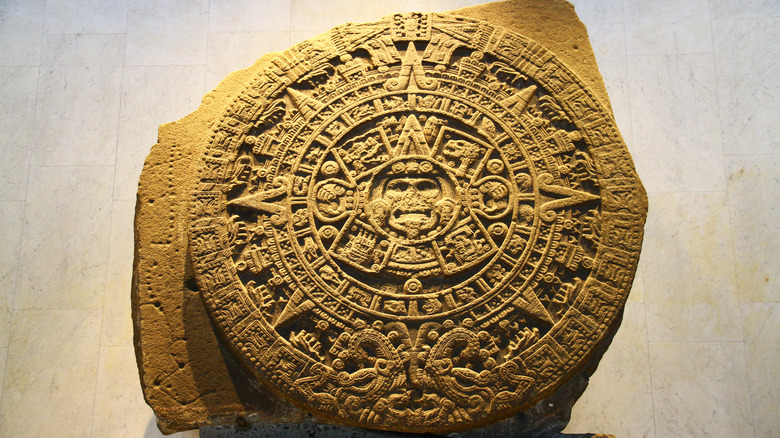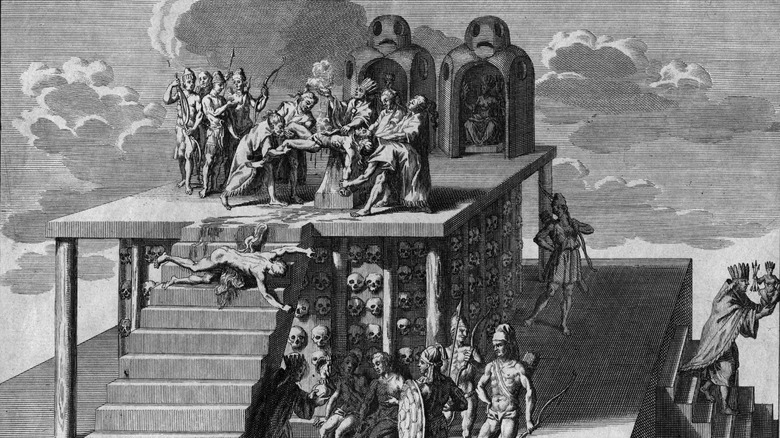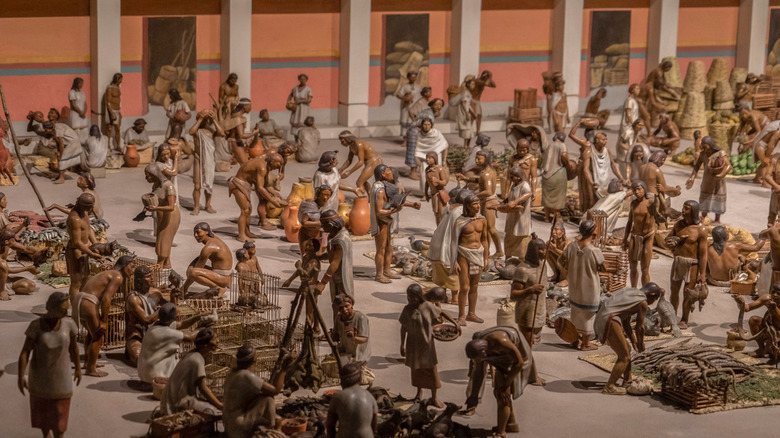Was The Aztec Sun Stone Really Used For Human Sacrifice?
Human belief systems have long been used as a justification for killing people. Whether it's a holy war in the name of Islamic Jihad, "ethnic cleansing" murders, or even mass suicides such as in the cases of the Jonestown Massacre or Heaven's Gate incident, there is something in the human condition which certain ideologies can exploit, making human death feel like a necessary means to some kind of end — even as most outsiders to that ideology look on with horror.
The Aztec people of ancient Mexico are another such example. Their polytheistic religion placed a heavy emphasis on the sun god, Tonatiuh, whom they saw as the god who provided "light, warmth, and life," according to what Mexican archaeologist Eduardo Matos Moctezuma told The Harvard Gazette. Because the sun was, and is, essential to maintaining life on earth, and because the Aztecs believed that the sun god could get angry and leave them high and dry, the Aztecs felt they needed to keep Tonatiuh happy. The way to do that was to keep him "fed," Moctezuma was said to have demanded.
Per Mythology Source, the Aztecs believed in a few sun gods prior to Tonatiuh, but he was the fifth incarnation. He was regarded as not easily pleased and less than benevolent. To keep this god happy, human sacrifice was essential to ensuring he, in the form of the sun, would come back every day. In fact, one of the reasons for this necessity was actually to honor the sun god for what were seen as sacrifices he had made in order for humanity to thrive, therefore, his nourishment required a blood and flesh sacrifice in return, per World History Encyclopedia.
Ritual human sacrifice required altars
For the Aztecs, a Mesoamerican civilization that rose to domination from 1345 through the 1520s until the Spanish colonized, human sacrifice was necessary to keep the world from coming to an end. That was integral to their belief system.
According to World History Encyclopedia, sacrifice included getting pretty messy with blood-spilling, heart removal, burning, and some dismembering, and often burned flesh or blood would be put on or poured onto idols of the gods, so they could receive the offerings directly. Because the Aztecs were so fervent about feeding their fickle gods, it is believed that the Aztec Sun Stone, which was discovered by Mexican workers in 1790 buried in the ground of Mexico City's Zocalo, a public square in the heart of the city, was an altar for sacrifice, according to Florida Museum. The Sun Stone, an Aztec calendar, had been buried in that location by the contemptuous Spanish conquerors, per Wired.
Latin American art and archaeology curator at the Florida Museum of Natural History, Susan Milbrath, said the 12-foot-wide, three-foot-thick, hand-carved disc now called the Aztec Sun Stone was likely used for the "most treasured captives" in sacrifice because Tonatiuh's face seems to be "the heart" of the stone.
"That almost made it like a stage for public ritual," Milbrath said.
Prisoners of war were most often used in sacrifice
Per World History Encyclopedia, these sacrifices were most often unfortunate captives of war, and of those, the ones who were the best-looking or fought the hardest and bravest made the best offerings to the Aztec gods. Though sometimes a losing team in ritual ball-games and even children would be sacrificed. At other times, a gladiator-style display might be staged, with the chosen victim made to fight before ultimately dying by sacrifice anyway.
Though that may sound harsh to modern humans, the Aztecs were actually a sophisticated civilization, with highly developed systems of agriculture, socialization, and an understanding of astronomy. Wired reported that the Sun Stone took 52-years to carve, from 1427 to 1479, and it encompasses dual calendars used by the Aztecs, both agricultural and ritual time-keeping methods. The timing of the sacrifices were decided by the calendar, but its main purpose was not so much for time-keeping — though it did that — but rather, the Sun Stone's primary use was to sacrifice people on, where Tonatiuh could be directly appeased.
While ritual human sacrifice is somewhat of an alien practice in modern civilizations, it's clear that the Aztecs put a great deal of thought and effort into the rituals, believing it was necessary to appease their gods, who were closely aligned with nature. Today, we understand nature differently, but we are still at a loss to control it. For the Aztecs, human sacrifice was likely a futile effort to have some control over the whims of nature.


